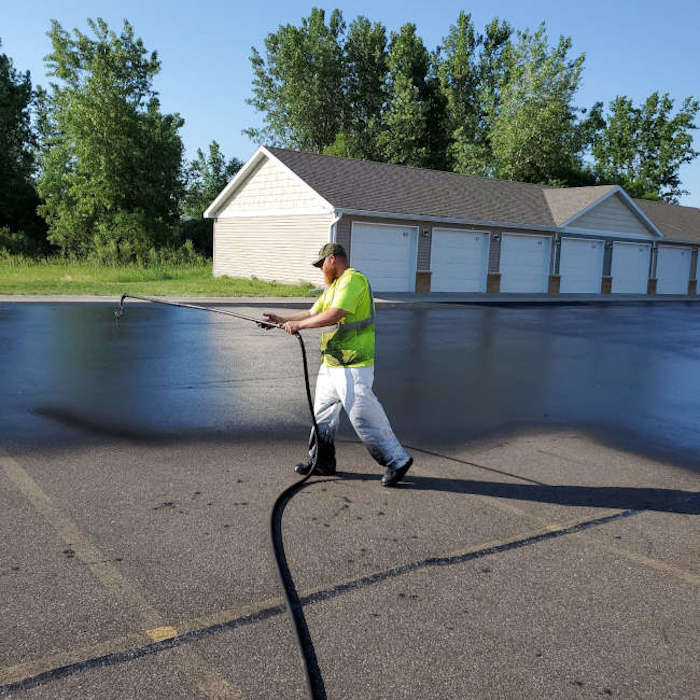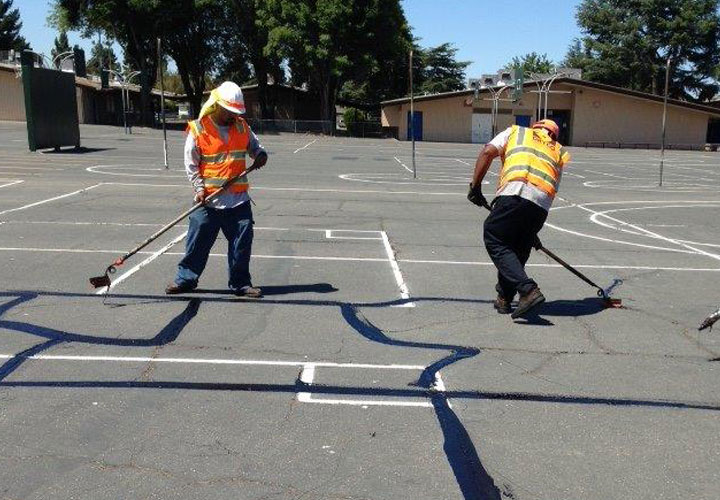Transform Your Residential property's Aesthetics: Commercial Parking Lot Paving and Asphalt Sealing Solutions
Warm Mix Asphalt: A Sustainable Remedy for Pavement
Warm Mix Asphalt (HMA) has actually become a leading lasting option for sidewalk solutions, providing a myriad of innovative innovations and environmental benefits. Its capacity to reuse products and minimize power intake provides an engaging instance for its adoption in road building and construction tasks. Additionally, the long-lasting efficiency and longevity of HMA make it a preferred choice for infrastructure advancement. As the need for environment-friendly building methods expands, checking out the subtleties of HMA's sustainability can provide useful insights into the future of sidewalk solutions.
Ecological Benefits of Warm Mix Asphalt

Additionally, Hot Mix Asphalt helps to reduce metropolitan heat island results. Its dark shade soaks up sunlight, minimizing the quantity of heat reflected back right into the atmosphere contrasted to lighter-colored pavements. This can lower ambient temperatures in city areas, reducing the need for a/c and ultimately lowering power intake.
Furthermore, Warm Mix Asphalt adds to enhanced stormwater administration. Its permeable nature enables water to penetrate the pavement and reenergize groundwater supplies, minimizing drainage and the threat of flooding. These ecological advantages make Warm Mix Asphalt a sustainable option for leading roadways and freeways.
Energy Effectiveness in HMA Production
Is power performance a vital variable in the manufacturing of Warm Mix Asphalt (HMA)? Power plays a considerable function in the production of HMA, affecting both cost and ecological sustainability. One essential aspect of power effectiveness in HMA manufacturing is the use of cozy mix asphalt (WMA) technologies.
Furthermore, innovations in plant innovations have led to even more energy-efficient HMA manufacturing processes. By enhancing energy usage in HMA manufacturing, the market can lower its carbon footprint while keeping high-quality pavement materials.
Recyclability of Warm Mix Asphalt
The recyclability of Warm Mix Asphalt (HMA) is a pivotal element of its sustainability and lasting environmental impact. HMA is among one of the most recycled products in the United States, with over 100 million bunches of reclaimed asphalt pavement (RAP) being recycled each year in new pavement building. Reusing HMA supplies several environmental advantages, such as reducing the requirement for Bonuses virgin materials, lowering power intake throughout manufacturing, and decreasing the amount of waste sent to garbage dumps.
The process of recycling HMA entails milling the existing pavement, crushing it into smaller pieces, and blending it with new accumulation and asphalt binder to develop a recycled mix. In general, the recyclability of HMA plays a substantial role in promoting sustainable methods within the pavement sector.

Long-Term Efficiency of HMA
Asphalt pavements show durability and resilience over an extended duration, reflecting the long-lasting efficiency of Warm Mix Asphalt (HMA) The longevity of HMA can be credited to its ability to hold up against hefty web traffic lots, rough weather conditions, and the impacts of aging. Research studies have actually revealed that properly designed and properly built HMA sidewalks can last for twenty years or even more with normal upkeep. The secret to taking full advantage of the long-lasting performance of HMA lies in using top quality materials, following best techniques in construction, and implementing reliable upkeep techniques. Proper drainage, routine inspections, and prompt fixings are essential for maintaining the architectural honesty of HMA sidewalks over time. Additionally, improvements in HMA modern technology, such as making use of polymer-modified binders and warm mix asphalt, have even more boosted the toughness and longevity of HMA pavements. By prioritizing quality building and upkeep techniques, HMA remains to show itself as a cost-efficient and lasting solution for durable pavement infrastructure.

HMA: Sturdiness and Sustainability
Demonstrating both durability and sustainability, Warm Mix Asphalt (HMA) has come to be a foundation in the construction of resilient pavement infrastructures - regrading. HMA's durability comes from its capability to endure hefty loads, harsh weather conditions, and high website traffic quantities, making it a reputable option for roads, freeways, and airport runways. The structure of HMA, which generally consists of aggregates, binder, and filler, plays a critical role in improving its longevity and resistance to tear and put on
Furthermore, HMA's sustainability depends on its recyclability and energy-efficient manufacturing process. The capability to recycle reclaimed asphalt pavement (RAP) in brand-new HMA combinations decreases the need for virgin products and minimizes the environmental influence of pavement building and upkeep. Additionally, the power performance of producing HMA depends on its reduced mixing temperatures compared to other pavement materials, causing lowered power consumption and greenhouse gas emissions.
Final Thought
In see this here final thought, hot mix asphalt (HMA) offers a lasting option for pavement with its environmentally have a peek at this website friendly attributes. HMA's recyclability, energy performance in production, and long-term durability make it an environment-friendly option for roadway building.
HMA is one of the most recycled materials in the United States, with over 100 million tons of redeemed asphalt pavement (RAP) being recycled every year in new sidewalk building.The process of reusing HMA includes crushing the existing sidewalk, crushing it right into smaller items, and mixing it with brand-new aggregate and asphalt binder to create a recycled mix.Asphalt sidewalks demonstrate durability and strength over a prolonged duration, showing the long-lasting performance of Warm Mix Asphalt (HMA) In addition, innovations in HMA technology, such as the use of polymer-modified binders and warm mix asphalt, have actually even more enhanced the durability and long life of HMA pavements. The ability to recycle recovered asphalt pavement (RAP) in new HMA mixtures lowers the need for virgin materials and decreases the environmental effect of pavement construction and maintenance.